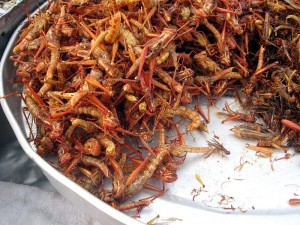
The famous grasshopper( Suborder: Caelifera) is known as an edible insect to many people. This is often a first insect meal to people who have never eaten insects or bugs before. They are eaten in substantial amounts, in south America, Africa, Asia and some parts of the Middle East. There are some species that change their behavior to swarm when populations increase, these are called locusts. Grasshoppers cover the globe, so nearly everyone can harvest this edible insect.
Edibility And Culinary Use
The taste is very good. It has a hardy flavor. There are no bad tastes or aftertaste. It often just tastes like a hardier version of the herbs and spices it’s cooked in. Grasshoppers should always be cooked when eaten, not because of anything inherent to the grasshopper, but they may contain parasites. Grasshoppers are eaten throughout the world in many ways including, fried, baked, mashed, cooked over fire, and boiled in salt, or soup.
Health Benefits

The primary nutritional benefit is well known and that is its protein content compared to contents of fats and cholesterol. So in other words this is a great choice to get you protein but not put on a lot of pounds. Grasshopper is one thing you can fill up on and still feel good, this is a great way to stay thin and healthy.
Cautions
The only known caution besides for allergic reactions is that the grasshopper should be cooked, because there is a chance of it hosting an unwanted parasite.
Conclusion
You’ve all heard about eating bugs, and some say they’ll never try it. Eating grasshoppers is a common sense solution to the problems of lack of protein in some countries and overabundance of fats and cholesterol in others. So we should all be including grasshoppers in our diet, the outcome will be better health, who can argue with that.
Many of our readers find that subscribing to Eat The Planet is the best way to make sure they don't miss any of our valuable information about wild edibles.
See our privacy policy for more information about ads on this site






